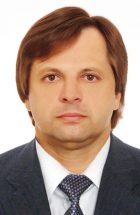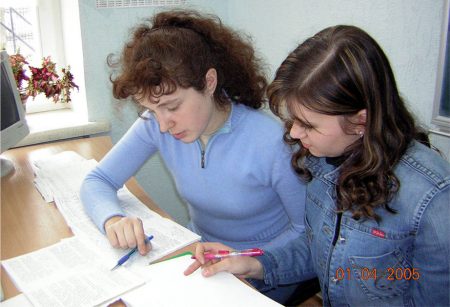SCIENTIFIC RESEARCH WORK OF THE DEPARTMENT
HEAD OF THE DEPARTMENT
Bantyukov Sergey EvgenievichHead of the Department, PhD in Sci. Tech., Associate Professor
The main areas of work of the Department of CE and CS are the development of automatic control systems, system modeling, Computer Engineering and non-traditional neuro-like computing and control systems.
The department has created all the necessary conditions for professional growth of scientific and pedagogical staff.
Among the scientific developments should be noted the work associated with the development of theoretical foundations for the construction of neuro-automatic grid structures, conducted under the guidance and with the participation of Professor, Ph.D. Filippenko Igor Grigorovich, who is the author of this new scientific direction.
The significance of the new scientific direction is that it lays the foundations for the construction of neuron-automatic reliable, fault-tolerant and viable grids of structures on which algorithms for various purposes can be implemented, in particular, digital control algorithms.
Within the framework of this direction, the university conducted research work on the following topics:
- “Development of the concept of building intelligent fault-tolerant and durable control systems.”
- “Development of the concept of building neural network and neurocomputer technologies of high-performance information processors.”
The main conclusions from these works are:
- for the first time the concept of construction of reliable, fault-tolerant and durable neural networks for realization of real-time computing and control systems on them is offered;
- for the first time the class of digital filters which can be realized on neuro-automatically grid structures is defined;
- for the first time methods of transformation of difference equations of digital filters to integer and integer form have been developed, which allows their representation in neuro-automatic grid form;
- for the first time, procedures for structural images of digital filter operations on neuro-automatic grid operations were proposed, which made it possible to formally represent the structures of integer, whole filters on neural-automatic grid structures
- for the first time, the methods of realizing the algorithm of the proportional-differential law of regulation on the neuro-automatic grid basis were developed;
- for the first time the concept of multilevel transfer functions was proposed, which allowed to propose the concept of construction of multilevel neuro-automatic mesh filters;
- the proposed for the first time method of synthesis of multilevel neuro-automatic grid PD-regulator fully uses all the accumulated theoretical and practical experience of designing automatic control systems in contrast to methods of synthesis of artificial neural control systems, the design of which is largely based on heuristic methods;
- for the synthesized PD-controller computer models of its components and computer model of the PD-controller as a whole by means of object-oriented programming in C++ language are developed;
- the obtained scientific results should be used in the construction of responsible and man-made systems, and the construction of neurochips, neurocomputers and synergistic neural networks for the implementation of reliable, fault-tolerant and durable real-time control systems;
- the obtained results provide a basis for the possibility of converting the obtained mathematical and computer models into a design language (VHDL or Verilog) over large integrated circuits;
- after creation of the basic basic components of probability-determined neuro-like network structures on VHDL or Verilog it is possible to pass to manufacturing over large integrated circuits, and after that to pass to industrial use of the received scientific and technical achievements;
- the licensing capacity of the obtained results is confirmed by 9 author’s certificates concerning the components of the neuro-automatic grid base;
- the investment attractiveness of the obtained results may be of interest only to those industries that create control systems for complex, man-made and dangerous objects, problems in which can lead to catastrophic consequences;
- the obtained results can also be used in promising projects related to the improvement of control systems at railway facilities, which will provide a given reliability, fault tolerance and surviving systems for a given period of system operation without human intervention in the system;
- the results obtained in the work can be used in higher education institutions in teaching disciplines of the latest information technologies;
- the results obtained on the construction of neuro-automatic networks can be attributed to the latest information technologies of the XXI century.
Under the guidance and participation of Dr. Ph.D., Professor Filippenko I.G teacher of the department Golovko O.V. in 2012 a dissertation was written and defended for the degree of candidate of technical sciences in the specialty 01.05.02 – mathematical modeling and computational methods on the topic: “Mathematical modeling of the process of fire propagation in transport infrastructure systems”. The dissertation is devoted to the prognostic assessment of threats to transport infrastructure objects from landscape fire. Data to determine the parameters of the threats are calculated using mathematical and computer models of the process of fire spread. For the synthesis of the above models, the macroprocess of fire is represented by a set of adequate microprocesses of combustion. For this purpose, models of three-dimensional cellular automata capable of modeling microscopic combustion processes using the description of combustion physics have been developed.
In 2019, the teacher of the department Yarovoy R.O. The dissertation on “Improving the performance of shunting locomotives through the use of combined energy storage” was defended, which included:
- methods for assessing the effectiveness of combined energy storage in the modernization of shunting locomotives ChMEZ;
- method of choosing the parameters of the combined energy storage for the modernized shunting locomotive ChMEZ;
- on the basis of patent №124916, class. B60L 13/00 “recuperative electric energy storage device of the locomotive electrical complex” developed a method of modernization of shunting locomotives series ChMEZ.
For the nearest period of time at the department with the leading role of Yarovoy R.O. research work was conducted on the following topics:
- “Development of a methodology for modernization of shunting locomotives based on the accumulation of regenerative energy.” GDR report – 0DR0116U005783.
- “Methodology for managing the technical operation of modernized rolling stock of the railways of Ukraine during its life cycle.” GDR report – № DR 0113U001029.
The student scientific society constantly works at the department. Every year students report at scientific conferences the results of their work, the abstracts of which are published in the collection of scientific works of the university.
Preparation of reports at SNTK
Ph.D., Associate Professor Golovko O.V







